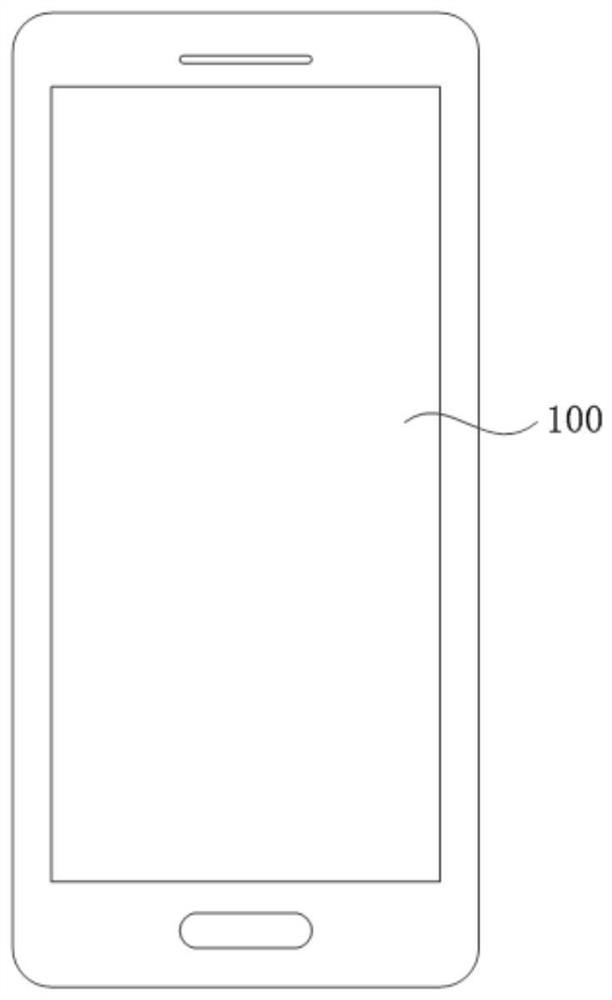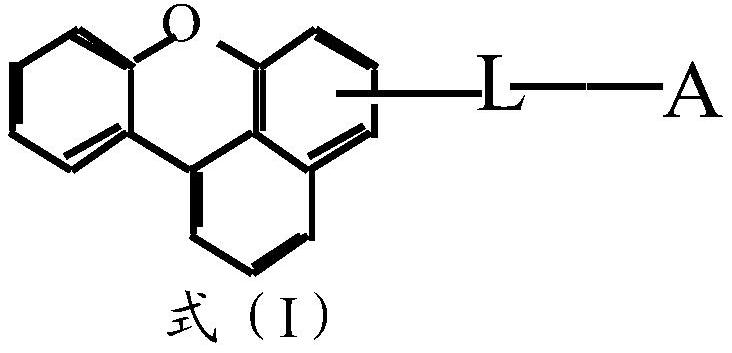Compound, display panel, display device
A display panel and compound technology, which is applied in the fields of compounds, display devices, and display panels, can solve problems such as difficult development of doped materials, and achieve the effects of improving equilibrium migration, high glass transition temperature and thermal stability, and reducing driving voltage
- Summary
- Abstract
- Description
- Claims
- Application Information
AI Technical Summary
Problems solved by technology
Method used
Image
Examples
Embodiment 1
[0107] Synthesis of Compound H002
[0108]
[0109] In a 250ml round bottom flask, add aphenoxanthene borate (10mmol), 2-bromo-4,6-diphenylpyridine (12mmol), and tetrakis(triphenylphosphine)palladium (0.6mmol) into 15ml In tetrahydrofuran THF, add 10ml of 2M K 2 CO 3 solution, stirred at a certain speed, and the resulting mixed solution reactant was heated to reflux at a reaction temperature of 80°C for 18 hours; after the reaction was completed, it was cooled to room temperature and 100ml of water was added, and the resulting mixture was filtered and washed three times in 25ml of dichloroethane , and finally dried over anhydrous magnesium sulfate. The resulting residue was further separated and purified through a silica gel column to obtain the product H002.
[0110] The elemental analysis structure of compound H002 (molecular formula C33 h 21 NO): Theoretical: C, 87.45; H, 5.90; N, 6.65; O, 2.03. Test values: C, 87.45; H, 5.91; N, 6.64; O, 2.02. ESI-MS (m / z) (M+) wa...
Embodiment 2
[0112] Synthesis of Compound H009
[0113]
[0114] In a 250ml round bottom flask, aphenoxanthene borate (10mmol), 2-bromo-4,6-diphenylacridine (12mmol), and tetrakis(triphenylphosphine)palladium (0.6mmol) were added In 15ml THF, add 10ml 2M K 2 CO 3 solution, stirred at a certain speed, and the resulting mixed solution reactant was heated to reflux at a reaction temperature of 80°C for 18 hours; after the reaction was completed, it was cooled to room temperature and 100ml of water was added, and the resulting mixture was filtered and washed three times in 25ml of dichloroethane , and finally dried over anhydrous magnesium sulfate. The resulting residue was further separated and purified by a silica gel column to obtain the product H009.
[0115] The elemental analysis structure of compound H009 (molecular formula C 32 h 20 N 2 O): Theoretical: C, 87.17; H, 5.90; N, 6.63; O, 2.11. Test values: C, 87.45; H, 5.91; N, 6.64; O, 2.12. ESI-MS (m / z) (M+) was obtained by li...
Embodiment 3
[0117] Synthesis of Compound H094
[0118]
[0119] In a 250ml round bottom flask, add aphenoxanthene borate (10mmol), 4-bromo-2,6-dinaphthylpyridine (12mmol), and tetrakis(triphenylphosphine)palladium (0.6mmol) into 15ml In tetrahydrofuran THF, add 10ml of 2M K 2 CO 3 solution, stirred at a certain speed, and the resulting mixed solution reactant was heated to reflux at a reaction temperature of 80°C for 18 hours; after the reaction was completed, it was cooled to room temperature and 100ml of water was added, and the resulting mixture was filtered and washed three times in 25ml of dichloroethane , and finally dried over anhydrous magnesium sulfate. The resulting residue was further separated and purified through a silica gel column to obtain the product H094.
[0120] The elemental analysis structure of compound H094 (molecular formula C 41 h 25 NO)): Theoretical: C, 85.09; H, 6.44; N, 1.95; O, 2.22. Test values: C, 85.09; H, 6.43; N, 1.96; O, 2.22. ESI-MS (m / z) (M...
PUM
| Property | Measurement | Unit |
|---|---|---|
| thickness | aaaaa | aaaaa |
| thickness | aaaaa | aaaaa |
| thickness | aaaaa | aaaaa |
Abstract
Description
Claims
Application Information
 Login to View More
Login to View More - R&D
- Intellectual Property
- Life Sciences
- Materials
- Tech Scout
- Unparalleled Data Quality
- Higher Quality Content
- 60% Fewer Hallucinations
Browse by: Latest US Patents, China's latest patents, Technical Efficacy Thesaurus, Application Domain, Technology Topic, Popular Technical Reports.
© 2025 PatSnap. All rights reserved.Legal|Privacy policy|Modern Slavery Act Transparency Statement|Sitemap|About US| Contact US: help@patsnap.com



